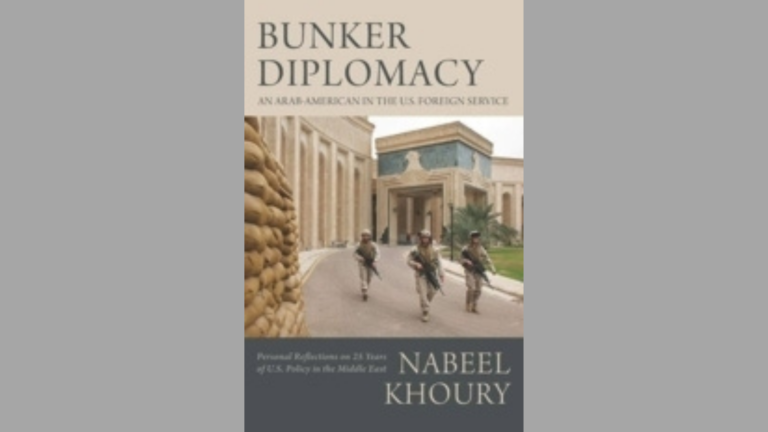
Nabeel Khoury’s newly released book, Bunker Diplomacy: An Arab-American in the U.S. Foreign Service, chronicles the process by which an Arab immigrant to the United States became an enthusiastic representative of American ideals in the Arab world as a foreign service officer. It is also a story of a not-so-appreciated foreign policy that, on many occasions, has also been detrimental to American national interests and the interests of a vast swathe of Arabs who were the direct targets of questionable and ill-advised decisions. One important—and fortunate—feature of this book is Khoury’s frankness about sensitive matters with which he dealt over long years of engagement in the Arab world as interlocuter with Arabs and explainer of US policy.
In this volume, Khoury appears free to relate events, debate ideas, and criticize practices and policies of a foreign policy establishment in charge of American relations with the Arab world. The book describes the author’s 25 years of foreign service work, explaining how American decisionmakers since the Reagan Administration saw the world and their role in it as well as critiquing some wrong turns they took at pivotal times. In fact, Khoury’s criticism of American policies in the Arab world is refreshing and gives credibility to the book and its author, who could not separate his deep knowledge of the region from some of the not-so-informed––one might say hubris-infused––policy choices. That higher-ups in the US Department of State respected his opinions and considered them justified, yet ignored his counsel on many occasions, is a reflection of the built-in inertia and bureaucratic thick-headedness to which the sprawling State Department is accustomed.
In Bunker Diplomacy, Khoury highlights his work and the political and social understandings he gained in five Arab countries: Egypt, Saudi Arabia, Morocco, Iraq, and Yemen. Before addressing his official engagement, however, he lays out his migration story from the mountains of Lebanon, where he cut his teeth on a deep intellectual tradition and the music and songs of Fairuz, the poetry of Gibran Kahlil Gibran, and the contradictions between sectarian and secular political parties and identities. He then relates his early and later images and difficulties navigating the expansiveness and contradictions of the United States, where he finished his higher education and went on to become a college professor. Throughout the book, the reader gleans insights into a transplanted poet-intellectual who ended up representing the foreign policy of a country simultaneously loved and derided by Arabs, many of whom knew that the United States had the option of not supporting Arab tyrants and self-serving politicians.
Khoury’s dedication to his duties appears to have been uniform throughout the book; but one cannot escape the feeling that he grew increasingly disappointed in how the United States conducted itself in the different countries where he served, and elsewhere. He obviously loved what he was tasked to do: to be a conduit of American culture and soft power to Arab societies, including their intellectuals, professionals, activists, and civil society organizations. His happiest recollections were of discussions with Arabs, men and women, about culture, ideas, religion, and all human endeavors he considered central to how a person may thrive and how a society may prosper and progress.
The assignment in Egypt was Khoury’s first and it was an eye-opener for the novice diplomat. There, he met the late Nobel laureate Naguib Mahfouz and discussed with him, among other things, religion and Salman Rushdie’s Satanic Verses. He also met with anti-Mubarak regime activists, including members of the Muslim Brotherhood, and with the late Farag Fouda, the secular activist assassinated by jihadists. In Egypt, Khoury was confounded, probably for the first time, by the enormity of American demagogic foreign policy according to which the United States promoted principles and ideas of democracy and human rights while simultaneously refraining from strongly condemning autocrats who deprived their people of such rights, like Egypt’s Mubarak at the time. The policy of coddling dictators deprived the United States of good relations with important political forces on the ground, like the Islamists, and with liberal intellectuals and activists who truly believed in US democracy and exceptionalism. Khoury’s regret about this and admonishment about its costs run throughout the book.
Khoury arrived in Saudi Arabia in 1990 at an especially unsettled time. Saddam Hussein invaded Kuwait, prompting not only panic in Riyadh and other Gulf capitals but also wider Arab and international responses, led by the United States. To Khoury, the American reaction to the possibility that Hussein may just continue on his way to conquer Saudi Arabia––an idea the George H. W. Bush Administration propagated––was unfounded. He writes that “[the] domino theory was invoked nonetheless to convince reluctant members of Congress to support the U.S. going to war” (p. 46). Still, Khoury found himself participating in propaganda videos about the conduct of the US military operation, Desert Storm, to justify the war against Saddam and convince the Arab public of the American position. But on Saudi issues, Khoury relates important information and writes incisive analyses and critiques of such matters as the status of women, the women driving ban, minorities, and al-Qaeda and political Islam, among other issues.
In Chapter 5, Khoury discusses probably his happiest time as a foreign service officer in Morocco, an Arab country where he served two tours. Although his posting exposed him to many of the transgressions of yet another authoritarian regime, he seems enamored of Moroccan civil society groups and activists who took it upon themselves to stand up and fight the “years of lead” (p. 73) when the late King Hassan II gave himself license to kill, imprison, torture, and intimidate everyone. The king was another one of those Arab rulers whom the United States avoided criticizing but one who “ruled with an iron fist” (p. 72). Khoury, however, could not abide coddling Hassan II and worked surreptitiously to build bridges to civil society activists and, indeed, met with many of them (he lists them with fictitious names; pp. 75-80). He also built bridges with Morocco’s Islamists who learned how to live with repression and, in the end––after Arab Spring agitation in 2011––became entrusted with power when King Mohammed VI asked Abdelilah Benkirane to form a government after his party, Justice and Development, won parliamentary elections that year.
The author’s service in Iraq appears to be the most painful for him. He opposed the American invasion of 2003 and criticized the conduct of the post-invasion period, which undoubtedly led to much of the country’s current political, economic, and social problems. He describes how the United States was convinced that it was doing the right thing by toppling Saddam Hussein, only to discover later that it offered the country on a silver platter to Iran and Iranian cronies inside Iraq. He writes that the Coalition Provisional Authority (CPA), established to run the country after the invasion, was a mess (p. 112) and chaos was the norm. The policies of dismantling the Iraqi army and of de-Baathification––urged on by the late Ahmad Chalabi––were irredeemable blunders (p. 117). Khoury may be consoled by the fact that, as he says, “the State Department played a secondary role in Baghdad,” letting Paul Bremer rule it through the CPA with “Donald Rumsfeld and Dick Cheney looking closely over his shoulders…” (p. 112).
Khoury’s posting in Yemen after 2007 was a very sad affair. He saw malfeasance in President Ali Abdullah Saleh’s regime and its wanton disregard of people’s rights and lives. Saleh was ruthless and presided over a corrupt polity (p. 123) and his wars with the Houthis were simply fights between elite groupings. Khoury minces no words (in the chapter on Yemen and elsewhere), saying that Iran was not assisting the Houthis and that the Houthis were not Iran’s stooges—which was not the narrative that Saleh used against his compatriots. Khoury also discusses the role that poor socioeconomic conditions played in creating the problem of terrorism in Yemen; in that, he went against prevailing wisdom among US officials who emphasized the need to keep arming the Saleh regime, which then used American aid against its domestic enemies. Khoury also had good relations with Yemen’s civil society activists like Nobel laureate Tawakkol Karman, Rahma Hujeira, Afrah Nasser, and Hafez Albukari, among others.
The book ends with a retrospective look at US policy toward the Arab Spring and how the Obama Administration appeared to be peripheral to its events. He writes that “[US] government analysts were … caught flat-footed by the events in Tunisia and Egypt as they first unfolded” (p. 212). The Muslim Brotherhood was actually acceptable to Washington after it affirmed its respect for regional red lines. Still, many in the administration were sorry to see Mubarak go, calling the ex-president a “remarkable gem” (p. 214). Obama’s administration also made mistakes in Syria by not helping the opposition early and when it counted; in Libya when it was at a loss as to how to help the post-Qadhafi period; and in Yemen by supporting the Saudi war against the Houthis (pp. 215-217). To Khoury, these faults continue to plague American policy in the Middle East under the Trump Administration as well.
The richness of Khoury’s book notwithstanding, two important developments in Saudi Arabia and Yemen should have received more discussion and analysis by the author because they portended serious repercussions. The first is the rise of the Sahwa movement in Saudi Arabia in the early 1990s when an organized Islamist renaissance dared to challenge the official religious-political orthodoxy of the kingdom. Sahwa’s stalwarts today are either in prison, have served jail sentences already, or have recanted their beliefs and now staff the ramparts in Saudi Crown Prince Mohammed bin Salman’s authoritarian modernization campaign. A look at the movement’s genesis would have enhanced Khoury’s book and portfolio since he served during its formative years—he must have been privy to some of its details.
The second salient development is the late Saleh’s repeated campaigns against the Houthis in Yemen. The Yemeni president began his internecine war against the Houthis in 2004, following decades of socioeconomic deprivation of their traditional region in northern Yemen. It would have been important to analyze the profound influence of his wars against the Houthis from 2004 to well into 2011—when Yemen’s version of the Arab Spring began—on the eruption of the pro-democracy movement in the country. That the Houthis were able to withstand the central government’s assault on them and, after 2011, to regroup to play a decisive role that led them to control roughly two-thirds of the country at present speaks volumes of their political and military acumen and abilities.
Despite these two glaring omissions and a need for some copy editing, Khoury’s book is certainly a good addition to any library on the Arab world and, essentially, on American foreign policy there. It is easy reading and contains previously unknown facts about the details of working in Arab capitals. Novices to American diplomacy, in particular, would do well to consult it before heading out to exercise America’s soft power in the Arab world.

